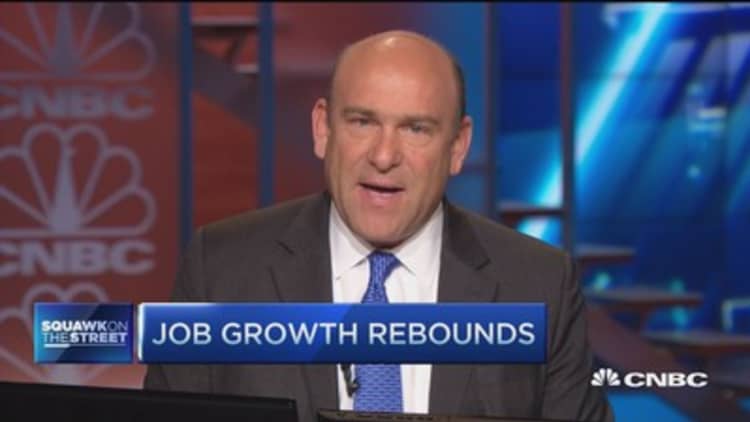
April's 223,000 nonfarm payrolls were strong enough to signal a rebound from the economy's first quarter decline, but weak enough to hold off Fed rate hikes until the second half of the year.
"It's a nice 'Goldilocks' report. We haven't had one in awhile," said John Canally, economist and market strategist at LPL Financial. "The people worried about the first quarter being more than transitory were happy. People worried about the Fed hiking in June, those people were happy."
Stocks surged, and Treasury yields, which had been edging higher over the past two weeks, reversed course. The 10-year yield, declining Thursday, continued to slip and was at 2.11 percent, well off Wednesday's high of 2.25 percent. Yields at the short end, most sensitive to rate hikes, also fell and the 2-year bond was at 0.58 percent.
"I think this argues they don't move in June," Moody's Analytics chief economist Mark Zandi said of the Fed. "I just can't see them going with this kind of job growth, and average hourly earnings didn't look that great either. I think they wait a little longer. I think this should help the markets out, at least (stocks) staying at these record highs for the next couple of months."
The April nonfarm payrolls were nearly identical to the consensus forecast of 224,000, and the decline in the unemployment rate to 5.4 percent was as expected. That showed a solid spring back from March's 85,000 jobs, after revisions.
Read MoreU.S. economy created 223,000 jobs
Traders in the bond market were focused on the average hourly earnings, which increased just 0.1 percent, one-10th less than expected. The increase was 2.2 percent year over year, while it was 2.3 percent last month.
"The (stock) futures are rallying here on the average hourly earnings number being a touch less than expected," said Peter Boockvar, chief market analyst at Lindsey Group. A 0.7 percent gain in the employment cost index last week had the market on high alert for a bump in hourly wages, since wage inflation could get the Fed to react.
"The market doesn't expect a June rate hike anyway. The fed funds futures keep telling you that," Boockvar said. "The economy remains mediocre, and we're seeing that across a variety of economic statistics. ... We still have another payroll number. If the next report (hourly wage gains) all of a sudden accelerates to 0.3/0.4 percent, then June is back on the table."
Wall Street expects the first Fed rate hike could be in September at the earliest, but the futures indicate it will more likely by December. However, market expectations for those time frames are also moving lower.
Dan Greenhaus, global market strategist at BTIG, said fed funds now show the probability of the first rate hike at just 20 percent for September, down from 26 percent as of Thursday. The odds on December fell to 47 percent from more than 50 percent, he said.
Greenhaus said the bets are going the wrong way. "I think rates should be going higher as the year progresses because I think these guys want to hike in September. They're going to hike," he said. "There's a lot of people who think they're not going to hike at all."
Many economists now expect a revision of first quarter GDP to show a decline of about 0.4 percent. The question has been whether second quarter growth would spring back as much as expected, and some economists have been slashing forecasts to growth more in the 2.5 percent range from over 3 percent.
Read MoreBad news on jobs, good news for stocks - analyst
"I think it's going to be a struggle to get 200,000 (jobs) at least for the next three or four months, as the energy sector adjusts to lower oil prices and manufacturing adjusts to the higher dollar," said Zandi. He expects second quarter growth of about 2.5 percent.
"It's going to be another pedestrian quarter. Lower energy prices and the negative consequences of lower oil prices are all front loaded." He called the April report "solid" and "sturdy" but said he expects job growth to return to the 250,000 level after a few months at a lower pace.
The economy added 62,000 jobs in professional and business services in April, about 30,000 more than the recent monthly pace. Construction employment rose by 45,000, a signal of a weather-related bounce back after the first quarter's harsh winter.
Health-care hiring also increased by 45,000, but employment in mining fell by 15,000. The mining category includes energy workers.
"The economy added 600,000 to 700,000 jobs this year despite the fact mining jobs are off by 50,000," Canally said.
"But I think overall, it's a nice 'Goldilocks' report. The market has kind of been in a funk in the last couple of days. The fact we got a nice dead-center report is a help," he said.


